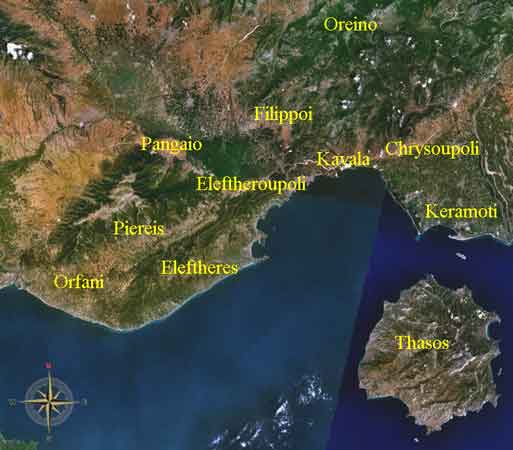|
|
After a period of Latin occupation, it was captured by the Turks in 1462; it was given by the Sultan Mahmud II to Mehemet Ali of Egypt. In 1914 during the Balkan Wars, Thasos became part of Greece. Thasos, the capital, stood on the north side of the island, and had two harbours, one of which was closed. Archilochus described Thasos as "an ass's backbone crowned with wild wood," and the description still suits the mountainous island with its forests of fir. The highest mountain, Ipsario or Ypsario, is 1045 m (3428 ft) high. Besides its gold mines, the wine, nuts and marble of Thasos were well known in antiquity.
Today, Thasos is a part of the
Mining activities for base and precious metals started in the 7th century B.C. with the Phoenicians, followed in the 4th century by the Greeks and then the Romans. The mining was both open - pit and underground, and concentrated on the numerous karst hosted calamine deposits for lead and silver although there was also minor exploitation of gold and copper. Worth mentioning is the discovery of a paleolithic addit located at Tzines iron mine, whose age has being estimated at approximately 15.000 years old, (Kovkouli et. al. 1988) for the exploitation of limonitic ochre.
More recently, mining companies such as Speidel (1905-1912) and Vielle Montagne (1925 - 1930) exploited the Zn-Pb (calamine) ores which had reported grades over 12% Zn+Pb. In 1905 a metallurgical plant was erected at Limenaria for the calcination of the calamines in vertical and Oxland furnaces to produce ZnO. Later (1926) the calcination plant was rebuilt by Vieille Montagne with Waelz system rotary furnaces. Iron ore mining became important during the years 1954-1964. Several mining companies (Krupp and Apostolopoulos A.E., Chondrodimos S.A.) exploited the iron ore deposits of the island. It is estimated that total mineral production during the period 1905-1964 was about 2 million tonnes of calamine (12% Zn+Pb) and 3 million tonnes of iron ore (44% Fe). After 1964 there is no mining activity on the island.
A new exploration effort was initiated in 1976 by IGME aimed at locating hidden primary base metal mineralization. Core drilling resulted in the discovery at the Marlou prospect, in 1979, of a stratabound primary Zn - Pb deposit at 200 m depth. The marble quarrying had a parallel history with the mining activity until the Byzantine period. In the present, starting about forty years ago, the marble quarrying is the only activity concerning the mineral wealth of Thasos.

, street map not yet available
Coordinates: 40 ° 46' 34'' N 24 ° 42' 39'' E
Notes
- ^ "The Thasians, who are Phoenicians by descent, and sailed from Tyre, and from Phoenicia generally, together with Thasos, the son of Agenor, in search of Europa, dedicated at Olympia a Herakles, the pedestal as well as the image being of bronze. The height of the image is ten cubits, and he holds a club in his right hand and a bow in his left. They told me in Thasos that they used to worship the same Heracles as the Tyrians, but that afterwards, when they were included among the Greeks, they adopted the worship of Heracles the son of Amphitryon." (Pausanias, 5.25.12.
- ^ "In the wish to get the best information that I could on these matters, I made a voyage to Tyre in Phoenicia, hearing there was a temple of Heracles at that place, very highly venerated. I visited the temple, and found it richly adorned with a number of offerings, among which were two pillars, one of pure gold, the other of smaragdos, shining with great brilliancy at night. In a conversation which I held with the priests, I inquired how long their temple had been built, and found by their answer that they, too, differed from the Hellenes. They said that the temple was built at the same time that the city was founded, and that the foundation of the city took place 2,300 years ago. In Tyre I remarked another temple where the same god was worshipped as the Thasian Heracles. So I went on to Thasos, where I found a temple of Heracles which had been built by the Phoenicians who colonised that island when they sailed in search of Europa. Even this was five generations earlier than the time when Heracles, son of Amphitryon, was born in Hellas. These researches show plainly that there is an ancient god Heracles; and my own opinion is that those Hellenes act most wisely who build and maintain two temples of Heracles, in the one of which the Heracles worshipped is known by the name of Olympian, and has sacrifice offered to him as an immortal, while in the other the honours paid are such as are due to a hero." (Histories 2.44.
- ^ Hugh Johnson, Vintage: The Story of Wine pg 39. Simon and Schuster 1989
References
- N. Epitropou et al.: "The discovery of primary stratabound Pb – Zn mineralization at Thassos Island", L’ Industria Mineraria n. 4, 1982.
- N. Epitropou, D. Konstantinides, D. Bitzios: "The Mariou Pb – Zn Mineralization of the Thassos Island Greece.", Mineral deposits of the Alps and of Alpine Epoch in Europe ed. by H. J. Echneibert, Spring – Verlag Berlin Heilderberg, 1983.
- N. Epitropou et al.: "Le mineralizzazioni carsiche a Pb – Zn dell’ isola di Thassos, Grecia.", Mem. Soc. Geol. H. 22, 1981, pp. 139-143.
- Omenetto P., Epitropou N., Konstantinides D.: "The base metal sulphides of W. Thassos Island in the Geological Metallogenic Frame work of Rhodope and Surrounding Regions.", International Earth Sciences Congress on AEGEAN Regions, 1-6 October 1990, Izmir -Turkey.
- Epitropou N., Omenetto P., Constantinides D., "Μineralizations a Pb – Zn comparables au type ' Missisipi Valley'. L'example de l'ile de Thassos ( Macedoine, Grece du Nord)", MVT WORKSHOP, Paris, France, 1993.
|
Ancient Greece
|
Medieval Greece / Byzantine Empire
|
Modern Greece
|
|
Science, Technology , Medicine , Warfare
, Biographies , Life , Cities/Places/Maps , Arts , Literature , Philosophy ,Olympics, Mythology , History , Images
|
Science, Technology, Arts
, Warfare , Literature, Biographies
Icons, History
|
Cities, Islands, Regions, Fauna/Flora ,
Biographies , History , Warfare
Science/Technology, Literature, Music , Arts , Film/Actors , Sport , Fashion
|

|
|



